- EAER>
- Journal Archive>
- Contents>
- articleView
Contents
Citation
Article View
East Asian Economic Review Vol. 26, No. 3, 2022. pp. 227-253.
DOI https://dx.doi.org/10.11644/KIEP.EAER.2022.26.3.412
Number of citation : 2Empirical Analysis of the Factors Affecting FTA Utilization by Exporting SMEs: Evidence from the South Korean Textile Industry
|
Tokyo International University |
Abstract
Despite the proliferation of free trade agreements (FTAs), many exporting firms are still confronted with several challenges in utilizing the FTA preferential tariffs. Based on the Technology–Organization–Environment (TOE) framework, this study empirically examines the factors affecting the utilization of FTA schemes by exporting firms. To clarify the key factors influencing FTA utilization, this study develops a conceptual model from the perspective of the adoption of information technology innovations. Eight factors derived from the TOE framework are proposed to explore the determinants of FTA utilization in export. Partial least squares structural equation modeling is employed to analyze the data collected from 162 exporting small- and medium-sized enterprises in the South Korean textile industry. The findings reveal that compatibility and trading partner influence are positively associated with FTA utilization, while complexity is negatively related. Factors of organizational context do not show any relationship with FTA utilization. This study is the first to theoretically analyze and empirically test the determinants of FTA utilization from the perspective of technological innovation adoptions. By examining the relative importance of TOE factors in the utilization of FTA schemes, this study expects to advance a holistic understanding on the perceived factors that could potentially affect the utilization of FTA schemes.
JEL Classification: F14, F15, M16
Keywords
Free Trade Agreement, FTA Utilization, Technology–Organization–Environment Framework, Small- and Medium-sized Enterprises
I. Introduction
As the conclusion of FTAs has increased substantially in the past decades, its utilization has received great attention as a vital tool for firms to maintain and improve their export competitiveness (Song and Moon, 2019). According to the World Trade Organization (2022), as of March 1, 2022, 354 regional trade agreements including FTAs and customs unions are in force worldwide. These regional arrangements provide firms greater global market access through the reduction or elimination of tariffs and non-tariff measures. Exporting firms can ensure considerable cost savings by the utilization of FTA schemes, since the FTA preferential tariff rates are mostly lower than the general tariff or most favored nation (MFN) tariff rates (Hayakawa et al., 2014).
However, while FTA utilization is a key competence that firms use to achieve export performance, many firms are still confronted with several challenges in utilizing the preferential tariff rates under FTA schemes (Song and Moon, 2019). In particular, the small- and medium-sized enterprises (SMEs) with a lack of knowledge and business resources tend to have difficulty in using the FTA preferential tariffs (Hayakawa, 2015a). One of the reasons is that the utilization requires firms to incur some additional costs since FTA preferential tariff rates are not applied automatically in customs procedures (Kasteng et al., 2022).
As evidence suggests that not all exporting firms are rushing to utilize preferential tariffs despite the proliferation of FTAs, the factors affecting firms’ FTA utilization have recently attracted increasing attention from the academic and business communities (Song and Moon, 2019). However, there are no sufficient studies investigating the determinants of FTA utilization owing to the difficulties of obtaining data (Wignaraja, 2014). Using the secondary data obtained from the government agencies, some studies have shown that the use of FTA preferential tariffs mainly depends on its costs and benefits (Hayakawa et al., 2014; Kim and Cho, 2010). While several research has been conducted from the perspective of firm characteristics using survey data (Hayakawa et al., 2013; Hayakawa, 2015a; Wignaraja, 2014), few systemic analyses have been conducted to validate the key factors affecting the utilization of FTA preferential tariffs by exporting firms.
Considering these research gaps, this study investigates the factors affecting the use of preferential tariff rates by exporting SMEs and thereby contribute to the literature on the utilization of FTA schemes. The contribution of this research is twofold. First, to answer the research question, this exploratory study develops a research model that examines the utilization factors from the perspective of the adoption of technology innovations. In particular, this study first adopts the technology?organization?environment (TOE) framework suggested by Tornatzky and Fleischer (1990) to comprehensively assess the perceived factors influencing firms’ FTA utilization. Although prior studies found factors that explain why firms are reluctant to use the preferential tariff schemes, they mainly focused on the perspective of the costs and benefits (Hayakawa, 2015a). According to the economic perspective, firms should voluntarily and actively utilize the preferential tariffs when the benefits exceed the costs of FTA utilization. However, there is still a lot of ambiguity surrounding the use of FTA schemes by firms. Particularly, although the external environment presents both constraints and opportunities for FTA utilization, previous studies have ignored the environmental context. Unlike other analytical frameworks that have been used studies in technology adoption, the TOE framework considers the external environment context as one of important drivers for organizational innovativeness (Oliveira and Martins, 2011). By examining the relative importance of TOE factors in the utilization of FTA schemes, this study expects to advance a holistic understanding on the perceived factors that could potentially affect the utilization of FTA schemes.
Second, the research model and hypothesized relationships are empirically tested by survey data collected from 162 exporting SMEs in the South Korean textile industry. In 2019, the value of South Korea’s exports of textile and apparel was over 1.1 billion dollars, making it the 10th largest exporter in the world (KOFOTI, 2021). Most textile and apparel have been exported to its FTA partners, such as Vietnam, China, and the United States. Despite the decline in domestic production and exports resulting from the offshoring of manufacturing facilities, the textile industry accounts for approximately 6.5% of the total employment in South Korea’s manufacturing sector in 2019. The textile exporting firms may have a relatively high incentive to use preferential tariff rates because the MFN rates remain high compared to other manufacturing products in both developed and developing countries. Nevertheless, FTA utilization rates are relatively low in the textile industry (Table 1), while exporting firms may overcome low price competitiveness by using preferential tariff rates. This study focuses on the importance of evaluating the determinants of FTA utilization at the firm level, using the case of South Korea, which has aggressively concluded FTAs with its major trading partners and has actively encouraged firms to use FTA preferential tariffs.
The rest of this paper is structured as follows. In Section II, we review the relevant literature on firms’ FTA utilization. Section III presents the theoretical background and hypotheses. The research methodology is described in Section IV, while the results of the statistical analysis are summarized in Section V. Finally, Section VI discusses the study and draws conclusions.
Ⅱ. Literature Review
FTA utilization is generally defined as the procedure of employing the preferential tariff rates in the export or import of goods (Kawai and Wignaraja, 2011). Specifically, the procedures of employing FTA schemes include meeting the rules of origin (ROO) of each FTA, acquiring the certificate of origin (COO), and submitting the COO to customs in importing countries (Hayakawa et al., 2013). Although the procedures of proving the origin of goods incur additional costs, FTA utilization has a positive effect on firms’ export performance (Hayakawa, 2015b). The use of FTA preferential tariff rates reduces export costs as a result of lower tariff payments. As such cost savings contribute to the improvement of export competitiveness, firms are expected to increase their exports to the FTA member countries.
However, despite the various benefits offered, many exporting firms have been reluctant to utilize FTA preferential tariff rates (Song and Moon, 2019). Except for the additional expenses incurred in the process of FTA utilization, such as the administrative and documentation costs required to obtain a COO, the use or non-use of FTA schemes is affected by various factors (Wignaraja, 2014). For example, earlier studies argued an insufficient information as one of the reasons for not using FTA tariff rates (Takahashi and Urata, 2010). While considering the additional costs required for FTA utilization, some studies stressed on firm size (Hayakawa, 2015a). It is known that larger firms are more likely to use FTA schemes because they generally have more business resources and therefore have a greater capacity to handle tasks for acquiring the COO.
While research on the determinants of FTA utilization is relatively recent (Kasteng et al., 2022), a series of studies have focused on the costs and benefits of using preferential tariff schemes (Hayakawa, 2015a). Here, the costs of FTA utilization can be divided into fixed and compliance costs. First, using FTA schemes entails large fixed costs (Kawai and Wignaraja, 2011). For example, firms must not only acquire knowledge and information about the complicate and complex ROO criteria of each FTA, but also establish an in-house management system to perform the necessary tasks to acquire the COO (Takahashi and Urata, 2010). In some cases, firms’ global supply chain and procurement system must be changed to meet the ROO (Hayakawa, 2015b).
Second, the compliance costs of FTA utilization are largely related to the restrictiveness of ROO. Using an index proposed by Estevadeordal (2000), which measures the difficulty in satisfying the ROO criteria, some studies analyzed the impact of ROO on FTA utilization. There are several ROO criteria to determine the origin of products in FTAs. Several studies revealed that more restrictive ROO reduces the utilization rates of FTA preferential tariffs (Kim and Cho, 2010; Hayakawa et al., 2014). It also implies that the more difficult and expensive it is to obtain a COO, the lower the FTA utilization.
However, exporting firms may aggressively use preferential tariff rates when the benefits of FTA utilization exceed the costs (Hayakawa, 2015b). The main benefit is likely to be tariff savings. Therefore, the larger the difference between MFN and FTA preferential rates, the greater the utilization of FTA schemes (Hayakawa et al., 2014; Ando and Urata, 2018). Similarly, transaction scale is also an important factor explaining FTA utilization (Kasteng et al., 2022).
As for the determinants of FTA utilization, although a series of studies have provided meaningful findings through secondary data analysis, the results focusing on perceived internal factors are still insufficient. Some studies merely examined the experiential factors, such as knowledge, experience, and organizational capabilities and structure, using the data obtained from surveys or interviews (Hayakawa et al., 2013; Wignaraja, 2014). One of the reasons for the scarcity of research at the firm level, noted by Wignaraja (2014), is the absence of micro data on FTA utilization rates. While previous research has made important contributions in our understanding of FTA utilization by exporting firms, it is apparent that further research is required based on a solid theoretical framework.
Ⅲ. Theoretical Background and Hypotheses
1. TOE Framework
Firms’ FTA utilization is very similar to the process of the adoption and implementation of the new information and technology (IT) system in organizations. Although no prior study has examined FTA utilization from the standpoint of innovation adoption, some beneficial knowledge can be obtained from theoretical and empirical research in the IT field. The adoption of IT innovation means the introduction of new methods, processes, and production systems for improving business performance and responding to changes in the external environment (Rogers, 2003). As with an IT innovation adoption, firms expect to face similar challenges in the progress of utilizing FTA preferential tariff rates. By this reasoning, FTA utilization can be viewed as the adoption of a new technology.
There are various theories explaining the process of new technology introduction (Dwivedi et al., 2012), of which the current study employs the TOE framework suggested by Tornatzky and Fleischer (1990). This framework is an effective and integrated model explaining the process whereby various kinds of IT innovations are adopted and diffused. With a robust theoretical framework, it has provided consistent empirical results (Oliveira and Martins, 2011). Accordingly, the TOE framework has also been used in a variety of studies focusing on the introduction of different types of innovations (Baker, 2012; Cruz-Jesus et al., 2019).
The TOE framework focuses on three contextual aspects: technological, organizational, and environmental (Tornatzky and Fleischer, 1990). First, the technological context refers to all the available technologies existing both inside and outside a firm, including those already in use and those that can be potentially introduced. Second, the organizational context pertains to the descriptive characteristics and available resources, such as the firm size, managerial structure, and human and financial resources. Finally, the environmental context is the arena in which the firm engages in business, including competition pressures and regulations (Tornatzky and Fleischer, 1990; Baker, 2012). In this framework, the dependent variable can observe not only IT adoption or acceptance, but also receptivity, business performance, extent of utilization, or a combination of other relevant variables (Ifinedo, 2011).
By using the generic theory of innovation acceptance (Ramdani et al., 2013), this study provides a new and comprehensive insight into FTA utilization by exporting firms, thus overcoming the limitations of the existing studies that mainly focused on the costs and benefits of preferential tariff schemes. The TOE framework is not a context-specific framework but rather a higher-level conceptual framework (Wang et al., 2016). Factors of the technological, organizational, and environmental contexts that affect innovation adoption are not specific. Thus, the empirical research has examined a variety of factors according to the contexts of new technologies (Oliveira and Martins, 2011). This study also examined several factors with a focus on FTA utilization while referencing previous research based on the TOE framework.
2. Technological Context
Concerning the innovation diffusion theory, there are three technological factors (Rogers, 2003). First, relative advantage is defined as “the degree to which an innovation is perceived as being better than the idea it supersedes” (Rogers, 2003: 229). It refers to the expected advantages that can be obtained from innovation adoption, which include tangible and intangible benefits such as profitability and response time improvement (Premkumar et al., 1994). If the benefits derived from the innovations are greater than that gained from the existing practices and processes, the advantages will positively influence its introduction (Oliveira et al., 2014). Following a similar perspective, firms are more likely to utilize FTA schemes when they perceive the relative advantages. Although the preferential tariff rates are generally lower than the MFN rates, not all firms are satisfied with the preference margins (Hamanaka, 2013). This implies that the use of FTA schemes increases based on the magnitude of benefits such as duty savings (Benguria, 2022). Therefore, the following hypothesis is proposed:
Compatibility is another important determinant of innovation adoption (Oliveira et al., 2014). Compatibility is defined as “the degree to which an innovation fits with the potential adopter’s existing values, previous practices, and current needs” (Rogers, 2003: 240). Since the adoption of new technology results in changes in the business style and process, it is highly likely that resistance to the change will arise inside the organization (Premkumar and Roberts, 1999). Thus, firms are more likely to adopt a new technology when the innovation is perceived as being compatible with the existing business practices and processes (Wang et al., 2016). Contrarily, perceived incompatibility of a new technology with existing business inhibits the adoption of innovation (Mallat and Tuunainen, 2008). From the same perspective, this study posits that firms are more likely to utilize FTA schemes when they perceive that FTA utilization is compatible with both their current exporting practices and production processes. FTA utilization may require firms to redesign their supply chain networks to meet the ROO criteria (Benguria, 2022). Accordingly, the following hypothesis is proposed:
The complexity of an innovation is usually negatively related to its adoption (Premkumar et al., 1994). Complexity is defined as “the degree to which an innovation is perceived as relatively difficult to understand and use” (Rogers, 2003: 257). Premkumar and Roberts (1999) suggested that the complexity of a new technology results in greater uncertainty in its successful implementation and increases the risk associated with the innovation adoption decision. The easier the introduction of the technology into business operations, the greater the possibility of its adoption (Oliveira et al., 2014). Consequently, it is expected that exporting firms are less likely to utilize FTA schemes when the use of preferential tariff rates is perceived as being complex and complicated. Complex and restrictive ROO results in a lower use of FTA schemes (Benguria, 2022). The complexity of FTA schemes increases compliance costs for firms. Thus, the following hypothesis is proposed:
3. Organizational Context
In the TOE framework, organizational context refers to not only the resources available to facilitate the adoption of an innovation, but also the characteristics of the firm that support or inhibit the adoption and implementation of the innovation (Oliveira et al., 2014). Firm size influences the adoption of a new technology (Ramdani et al., 2013). Large firms generally have an advantage over SMEs because they have more resources, skills, experience, and the ability to survive failures (Ramdani et al., 2013). Moreover, some studies have argued that large-scale firms are more likely to utilize FTA schemes (Hayakawa, 2015a). Large-scale firms might have sufficient capabilities and resources to handle the administrative tasks related to obtaining the COO (Benguria, 2022; Hayakawa et al., 2013). This means that the fixed cost of FTA utilization falls with firm size (Benguria, 2022). Thus, the following hypothesis is proposed:
Among the various factors affecting the relationship between organizational structure and the adoption of an innovation, top management support also plays a leading role in the adoption of a new technology because it guides the allocation of resources and the establishment of organizational climate conducive to adopting an innovation (Premkumar and Roberts, 1999). Moreover, such support is material to overcoming the resistance to organizational changes (Teo et al., 2009). The typical argument is that top management support is positively associated with the adoption of a new technology (Wang et al., 2016). Similarly, this study contends that exporting firms are more likely to use preferential tariffs when top managers pay attention to FTA schemes and support the utilization. Because the utilization of preferential tariffs requires company-wide support and collaboration in the process of meeting the requirements of ROO, top management support is critical to creating a supportive organizational climate (Song and Moon, 2019). Consequently, the following hypothesis is proposed:
Lastly, absorptive capacity, as used in previous research on innovation adoption, measures whether a firm has sufficient ability and a set of processes to effectively obtain and utilize both external and internal knowledge (Lin, 2014). As suggested by Cohen and Levinthal (1990), the absorptive ability to acquire knowledge is an essential component of innovative capabilities. A firm’s absorptive capacity expands its organizational adaptability and is thus expected to not only increase the likelihood of an innovation adoption, but also improve the ability to facilitate future technology implementation (Lin, 2014). In the context of FTA utilization, since a firm with a large absorptive capacity can obtain sufficient information and knowledge on FTA utilization, it is more likely to use preferential tariff rates. Wignaraja (2014) emphasized that the likelihood of firms utilizing FTA schemes was positively related with obtaining knowledge about FTAs and building technological capabilities. Thus, the following hypothesis is proposed:
4. Environmental Context
The TOE framework is very useful in assessing antecedents of innovation adoption and utilization because it also includes environmental factors (Picoto et al., 2014). The environmental context can be expressed as the arena or setting in which a firm operates its business and is influenced by the characteristics of the industry, the firm’s competitive pressures, access to resources supplied by trading partners, and interaction with the government (Oliveira et al., 2014). Of these, this study focused on trading partner influence and competitive pressures.
First, trading partner influence is important in determining the adoption of new technology, especially when the system involves business-to-business applications (Teo et al., 2009). Previous research has suggested that the firms that have already adopted an innovation system would attempt to influence their business partners to adopt the same system as well to increase their own benefits of adoption (Teo et al., 2009). Accordingly, firms are expected to maintain an effective relationship with their buyers or suppliers to increase the likelihood of an innovation adoption (Lin, 2014). Similarly, trading partner influence is an important component for FTA utilization. In fact, the utilization of FTA schemes is possible when all firms participating in the supply chain understand the ROO and meet the criteria of origin. To obtain a COO, all partner companies supplying parts and components must meet ROO requirements. Thus, the following hypothesis is proposed:
In the context of innovative technology, competitive pressure implies the degree of pressure recognized by firms from their competitors and, thus, it drives firms to seek competitive advantages by an innovation adoption (Lin, 2014). Since the introduction of new technology is often considered as a strategic necessity to compete in the marketplace, competitive pressure is positively associated with an innovation adoption by firms (Oliveira et al., 2014). Firms also introduce a new technology to reduce the risk of competitive disadvantage (Wang et al., 2016). Consistently, a firm that recognizes that it cannot maintain export competitiveness without utilizing FTA schemes is more likely to use the preferential tariff rates in their exporting activities. By using FTA preferential tariffs, exporting firms can benefit from lower tariff rates, higher price competitiveness, and better market access. As the competitive pressure increases, firms try to secure a competitive advantage through the utilization of FTA schemes. Thus, the following hypothesis is proposed:
Ⅳ. Research Methodology
1. Sample and Data Collection
To empirically test the research framework, a survey was conducted on the exporting SMEs of the South Korean textile industry. In 2019, there are 4,780 exporting firms in the textile manufacturing industry in South Korea (Statistics Korea, 2021). Among them, more than 97% are classified as SMEs. Generally, the textile industry has a complex supply chain, including spinning, weaving, dyeing, and finished textile products. According to the Korea Federation of Textile Industries (KOFOTI), however, more than half of South Korean textile manufacturers are concentrated in the production of final products such as apparels and garments. The textile industry has a large proportion of small businesses, which is defined as having 10 or fewer employees. Out of the total of 44,931 establishments operating textile industry, the proportion of small businesses was approximately 90% in 2019 (KOFOTI, 2021). Moreover, out of 5,047 firms with more than 10 employees, only 13.9% had an annual value of shipments of more than 10 billion won (KOFOTI, 2021). Nevertheless, South Korea’s textile manufacturing sector has a relatively high proportion not only of exporting firms but also of exports to sales (Statistics Korea, 2022).
The sampling frame was developed from the membership lists of the Korea Textile Trade Association (KTTA) and the KOFOTI, representing exporting firms operating in the textile industry in South Korea. Every firm was contacted by telephone from March 4 – 6, 2019. Since FTA utilization requires experience and expertise, the survey respondents were limited to full-time employees and managers in charge of export business or issuing COO at the company for at least two years. Out of the 1,597 member companies of the KTTA and the KOFOTI which were initially contacted, 162 respondents completed the questionnaires, yielding a response rate of approximately 10%. Table 2 summarizes the profile of the responding firms in industry sector, number of employees, sales, and share of exports in sales.
2. Measures of Construct
As a dependent variable of the model, this research evaluated the extent of a firm’s FTA utilization which is the proportion of the number of export contracts using FTA preferential tariff rates out of the total number of export contracts during the last year. This study used an 11-point scale as the extent of FTA utilization. As shown in Figure 2, out of the 162 firms that responded, 123 firms (79.9%) had experience utilizing FTA schemes in exporting. Among them, firms with a utilization rate of less than 10% accounted for the largest proportion, while approximately 22.8% of the respondents showed a high utilization rate of more than 70%.
All measures for the independent variables were developed through a comprehensive review of the literature related to the TOE framework and were modified to suit the FTA utilization context (Table 3). The items for the constructs of technological context were adapted from Moore and Benbasat (1991) and Oliveira et al. (2014). Comparative advantage was measured using four items that reflect the perceived benefits of FTA utilization to offer export opportunities, improve export performance, save export costs, and increase business productivity. Compatibility was measured by three items that assess whether FTA utilization is compatible with the existing business operation, situation, and style. Complexity was measured by three items that assess perceived difficulty for using preferential tariff schemes. Firm size was measured by number of full-time employees and categorized into six groups. (Teo et al., 2009; Ramdani et al., 2013). The items for top management support were adapted from Premkumar and Roberts (1999) and Teo et al. (2009), which assess the level of top management commitment to FTA utilization. Absorptive capacity assessed the ability of firms to utilize preferential tariff schemes using three items (Lin, 2014). Trading partner influence was measured using two items derived from Premkumar and Roberts (1999) and Teo et al. (2009), which assess the influence of business partners on FTA utilization. Competitive pressure was measured by three items developed from Oliveira et al. (2014) and Lin (2014), which assess the degree of pressures influenced by competitors. A five-point Likert scale ranging from “(1) disagree strongly” to “(5) agree strongly” was used for all items of the independent variables, excepting firm size.
This study controls for industry position, sales, and export ratio in FTA utilization. Industry position was considered because there is a difference in FTA utilization between firms that produce intermediate goods (upstream industry) and those that produce final goods (downstream industry). As mentioned by Hayakawa (2015a), the difference in production stage of goods affects firms’ FTA utilization. Industry position was operationalized as a dummy variable with a value of 0 if a firm is producing intermediate goods, such as raw materials, parts, and processed goods, and a value of 1 otherwise. Sales was measured by the average sales for the last three years and categorized into six groups. Export ratio was measured by the proportion of exports in sales and categorized into 10 groups.
3. Data Analysis
This study employed the partial least squares structural equation modeling (PLS-SEM) to test the proposed research model, using the statistical software SmartPLS 4 (Ringle et al., 2022). Hair et al. (2019) argued that the PLS method has become a good alternative to the covariance-based SEM for empirically testing a theoretical framework from a prediction perspective, especially when the sample size is small and distribution issues are a concern. While PLS-SEM is a kind of multivariate analysis based on ordinary least squares regression analysis, its primary goal is to estimate the latent variables, which cannot be observed directly but can be measured indirectly through several indicators (Avkiran, 2018). PLS-SEM has widely been applied in various research fields of social science because the method has the advantage of estimating complex models with many structural paths without strict assumption on data distribution (Hair et al., 2019). Moreover, PLS-SEM can be useful for exploratory research because we can evaluate the robustness of the model through the bootstrapping technique.
Ⅴ. Empirical Analysis
1. Measurement Model Assessment
Before considering the structural model, we need to assess the measurement model to examine the reliability and validity of the reflective measures for all the constructs (Hair et al., 2022). First, individual item reliability was measured by outer loadings of items. As shown in Table 4, all indicator loadings are greater than the recommended 0.708 threshold and are significant at the .01 level (Hair et al., 2019). As suggested by Hair et al. (2022), this research performed the bootstrapping procedure with 5,000 resamples to assess the significance of the loadings. Second, the values of Cronbach’s alpha and composed reliability are higher than the suggested 0.7 value, indicating the internal consistency reliability of the questionnaire (Bagozzi and Yi, 1988). Third, regarding the convergent validity of the scales, the average variance extracted (AVE) for all items on each construct should exceed 0.5 (Bagozzi and Yi, 1988). AVE values in the study are between 0.740 and 0.873.
Finally, as provided in Table 5, the correlations between each pair of constructs are less than the square root of the AVE of each construct, indicating discriminant validity of the constructs (Fornell and Larcker, 1981). Moreover, all the heterotrait-monotrait ratio (HTMT), presented in Table 6, are lower than the threshold of 0.9 (Hair et al., 2019). Therefore, we can conclude that reliable and valid constructs were used to test the proposed research model.
2. Structural Model Assessment
Prior to proceeding with the analysis of the structural model, the predictive power was assessed using the coefficient of determination (
The results of PLS-SEM are summarized in Table 7. First, as the values of variance inflation factor are all less than 0.5, there are no concerns of multicollinearity. The path coefficients and t-values were also estimated using the bootstrapping method (5,000 resamples). Within the technological context, compatibility (H2) (
Regarding control variables, industry position was found significant (
This study also calculated the effect size (
3. Endogeneity Test
While PLS-SEM has various advantages in estimating complex models with relatively small sample size, we need to assess the robustness of the structural model (Hult et al., 2018; Sarstedt et al., 2020). Specifically, the endogeneity problem may occur when an independent variable is correlated with the error term of the dependent variable. It mostly means that an important variable has been omitted from the regression model (Hair et al., 2019). It is impossible to consider all factors influencing FTA utilization in a single research model. However, when an omitted variable affects both the independent and dependent variables, the coefficient estimates are biased (Sarstedt et al., 2020).
To test the existence of endogeneity, this study applied the Gaussian copula approach suggested by Park and Gupta (2012) — a systematic procedure for assessing and treating endogeneity in PLS-SEM (Hult et al., 2018). This approach detects endogeneity by “directly modeling the correlation between the endogenous variable and the error term by means of a copula (Sarstedt et al., 2020: 8).” As shown in Table 8, none of the Gaussian copulas are significant (
Ⅵ. Discussion
This study examined the factors influencing the utilization of FTA preferential tariffs by exporting SMEs in the South Korean textile industry. To our knowledge, this study is the first to theoretically analyze and empirically test the determinants of FTA utilization from the perspective of technological innovation adoptions. Although previous research has presented empirical findings concerning several aspects of the use of FTA schemes, few studies have examined the utilization factors based on a comprehensive theoretical model. Thus, this study has important implications because it presents a theoretical framework to investigate the determinants of FTA utilization by exporting firms.
This study developed a research model to test the impact of eight contextual factors on FTA utilization. The results show that three factors influence the utilization of preferential tariff schemes: compatibility, complexity, and trading partner influence. Within the technological context, compatibility is a facilitator for the utilization of preferential tariffs rates. This finding is consistent with the conclusion that incompatibilities with existing business processes and practices become a potential deterrent to the introduction of a new technology innovation (Ramdani et al., 2013). Similarly, compatibility with the current export processes and practices is an essential ingredient for FTA utilization. Contrarily, complexity is an inhibitor in the use of FTA preferential tariffs. As with the adoption of IT technology, perceived complexity also inhibits firms’ FTA utilization. Accordingly, it appears that a lack of knowledge and expertise may lead to a decline in the use of preferential tariffs.
Contrary to expectations, three factors within the organizational context had no effect on the utilization of FTA schemes. These results are not consistent with previous studies concerning both innovation adoption and FTA utilization. While there may be differences in FTA utilization between large-scale companies and SMEs (Hayakawa, 2015a; Cho and Choi, 2020), the results reveal that firm size has no significant relationship with the use of preferential tariff rates. The finding is similar to that in Kasteng et al. (2022), who focused on the case of FTA between South Korea and the European Union. However, this finding differs from that obtained by Hayakawa (2015a), who concluded that large-scale firms use more FTA schemes. Further, top management support has also no significant impact on FTA utilization. In fact, top managers have a positive effect on both organizational learning and FTA utilization intention (Song and Moon, 2019). However, due attention should be paid to the fact that top management support is not necessarily tied to an increase in the actual utilization rate. Moreover, no significant relationship with FTA utilization was observed for absorptive capability either. As mentioned by Oliveira et al. (2014), even though firms recognize the need and ability to utilize innovation, specific factors in the technological context may prevent them from linking the benefits of new technologies. One possible explanation for the non-significant relationship between the factors within the organizational context and the extent of using FTA schemes is also that the utilization may be more affected by other factors, such as technological or external factors.
As for the environmental context, trading partner influence is the most significant factor influencing exporting SMEs to utilize FTA preferential tariffs. This finding has two possible interpretations. The first is that FTA utilization requires firms to build cooperative relationships with their suppliers or business partners participating in the supply chain networks. The second is that SMEs with a relatively weak bargaining power may passively utilize FTA schemes under pressure or following requests from their buyers or client companies. Thus, it cannot be ignored that the utilization incurs additional costs for exporting firms, although the actual benefits from tariff savings are generally enjoyed by importers. Although competitive pressure generally promotes the introduction of new technology (Premkumar and Roberts, 1999; Lin, 2014), the current results show that it has no significant effect on FTA utilization. In sum, although many exporting SMEs fully understand the usefulness of the preferential tariffs and that they have adequate knowledge and ability to use the FTA schemes, they have not recognized the need to do so.
This study also offers several key insights for both policy makers and managers to better understand the factors and conditions associated with FTA utilization by exporting SMEs. First, within the technological context, many exporting SMEs perceive various difficulties while they fully grasp the benefits of preferential tariffs. Thus, it is important for government agencies or industry organizations to provide knowledge and information concerning FTA schemes, since many SMEs are still experiencing complex and complicated ROO. Second, concerning compatibility, it is considerable that the utilization of FTA schemes may not be suitable for all exporting firms. While it cannot be denied that FTA utilization is a useful means to reduce tariff payments, there are several ways to save tariff costs, including the adoption of various export promotion programs. It is also possible that some are using other preferential schemes such as duty drawback. Finally, within the environmental context, the utilization of FTA schemes is heavily dependent on the enthusiasm of trading partners participating in supply chain networks and the requests of importers and buyers. Consequently, SMEs who have established a strong collaborative relationship with their trading partners are more likely to utilize FTA schemes and may thus achieve comparative advantage in their exporting activities. However, we cannot exclude the possibility that SMEs are passively using the preferential tariffs pressure or persuasion from domestic client companies or foreign importers, while they recognize the need to change their current business practices and processes to maintain competitive advantage amidst the intensification of competition in foreign markets.
While this study contributes to the literature on FTA utilization, there are some potential limitations that must be considered. First, since the sample is limited to only 162 exporting SMEs in the South Korean textile industry, there is a concern about the generalization of the results. Samples obtained from other countries could provide different results. Second, instead of the eight factors discussed in this study, numerous other TOE factors may also affect firms’ FTA utilization. Future studies can examine whether other factors also affect the use of FTA preferential tariffs. Lastly, despite the importance of institutional factors such as the restrictiveness of ROO, this study only focused on the TOE factors from the perspective of new technology adoption. Hence, future research should fill this research gap by integrating the TOE framework with other theoretical lenses.
Tables & Figures
Table 1.
FTA Utilization Rates in South Korea
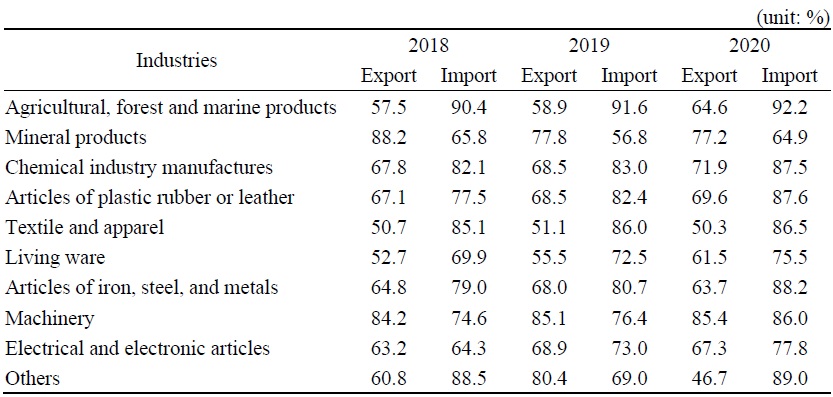
Source: Korea Customs Service.
Figure 1.
TOE Framework and FTA Utilization: A Conceptual Model
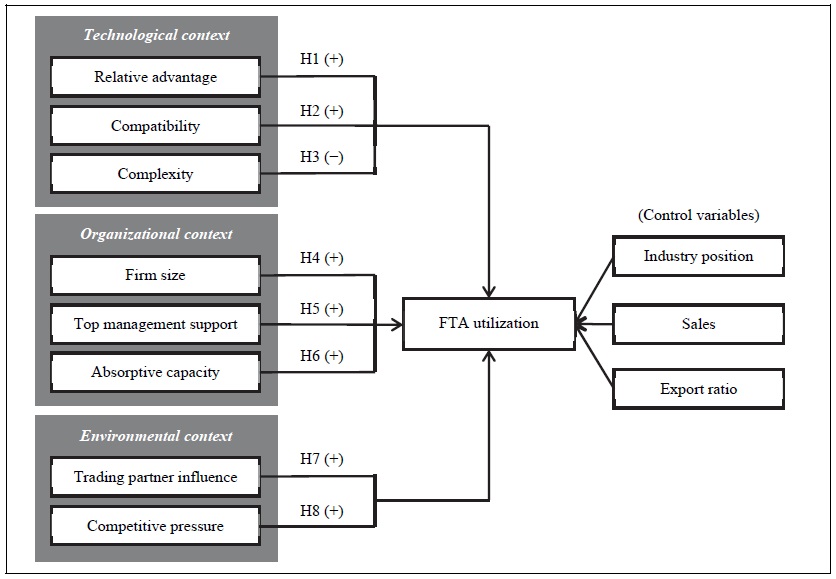
Table 2.
Sample Profile (n = 162)
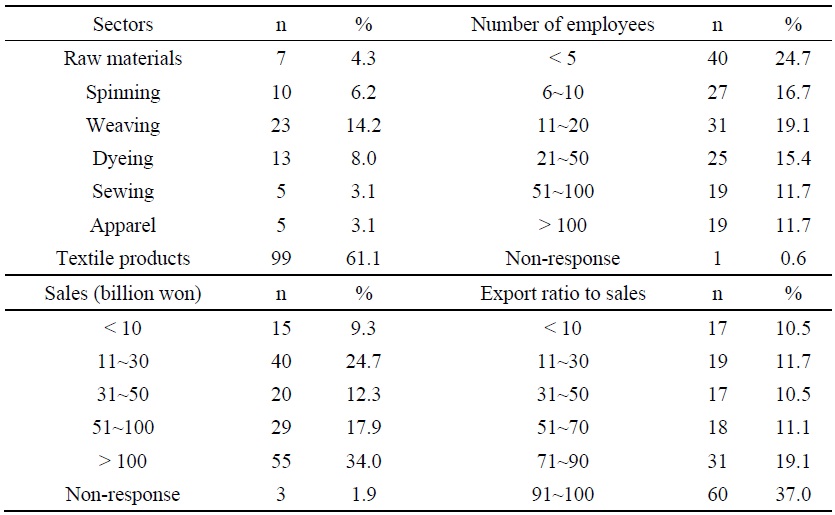
Figure 2.
Distribution of FTA Utilization Rates
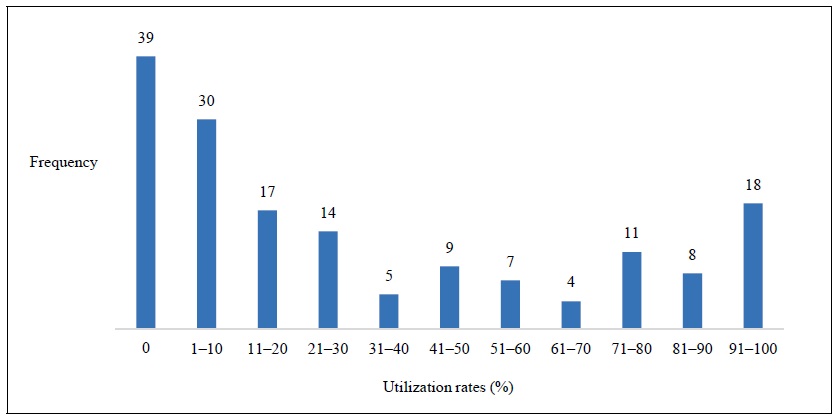
Table 3.
Measurement Items
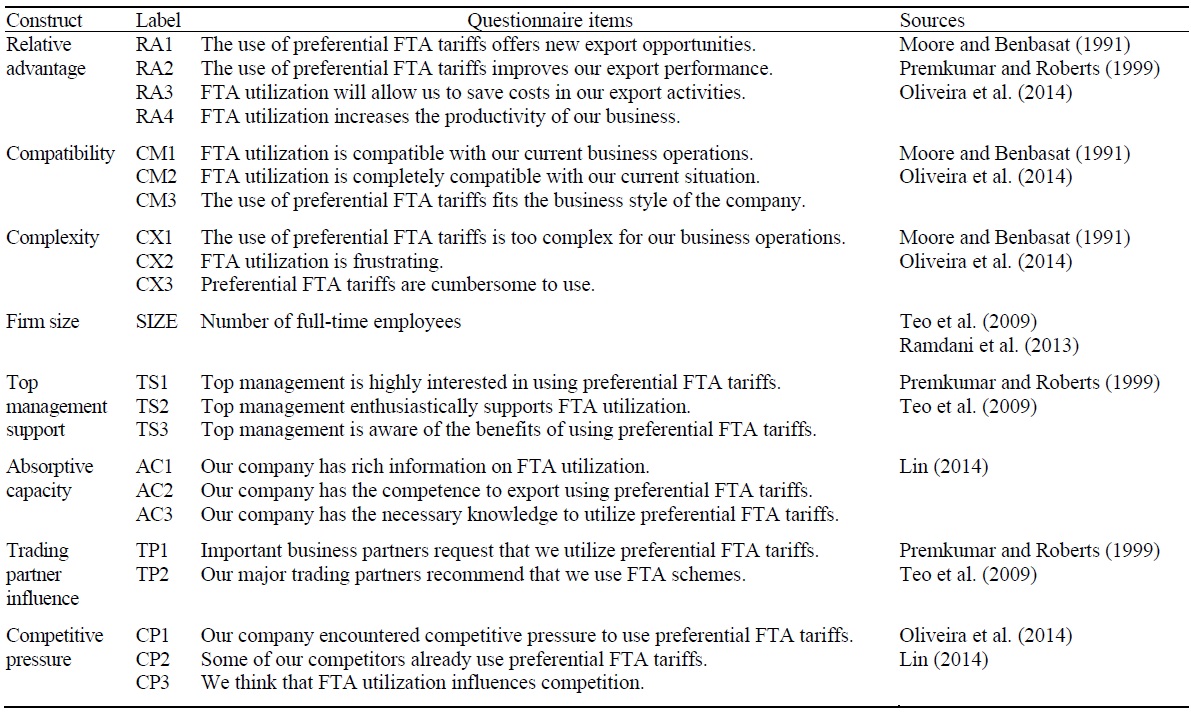
Table 4.
Results of Validity and Reliability Tests
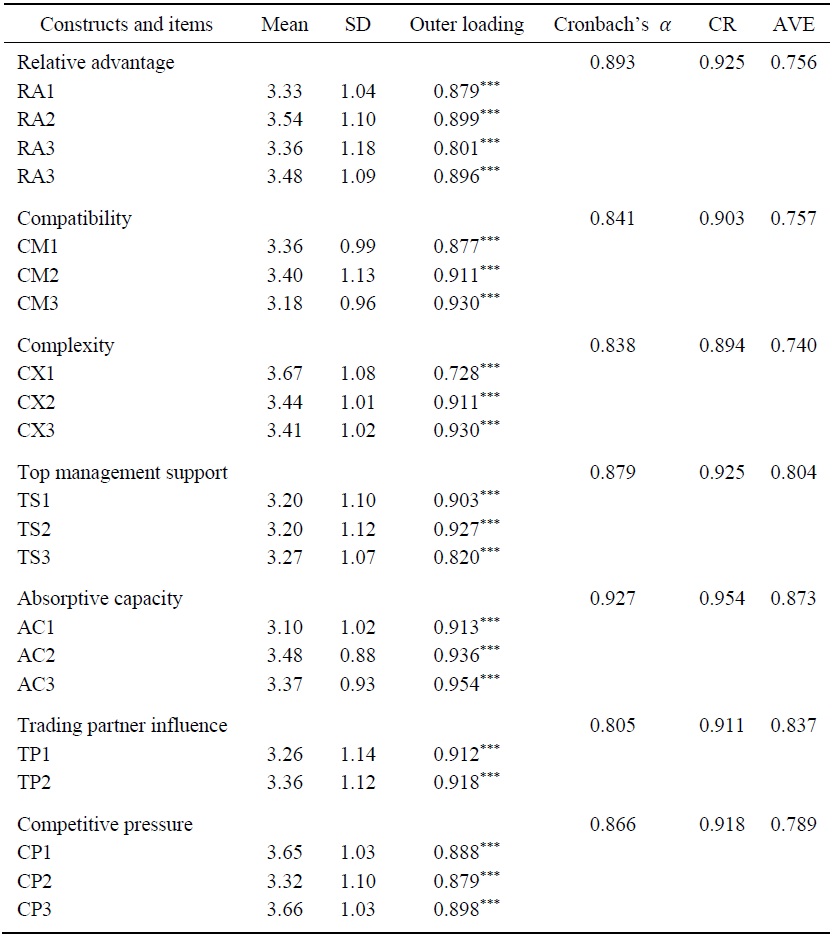
Notes: *** significant at the 0.01 level. Bootstrapping based on 5,000 resamples.
Table 5.
Fornell-Larcker Criterion (Correlations and Square Root of the AVE)
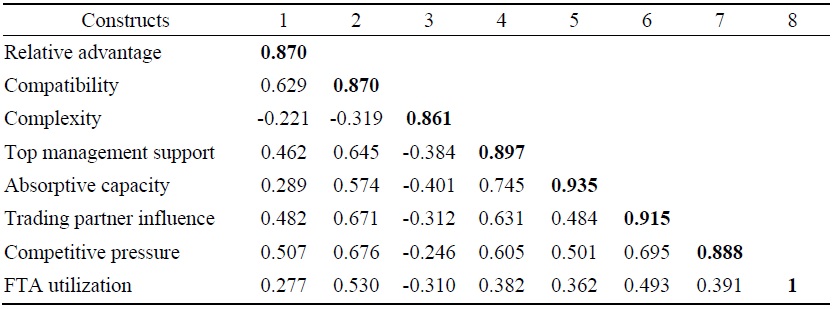
Note: The diagonal elements (in bold) are the square root of AVE for reflective constructs.
Table 6.
Heterotrait-Monotrait Ratio (HTMT)
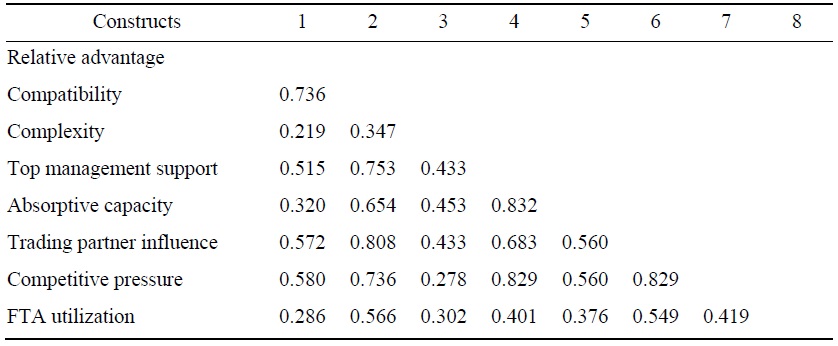
Table 7.
Results of PLS Estimation
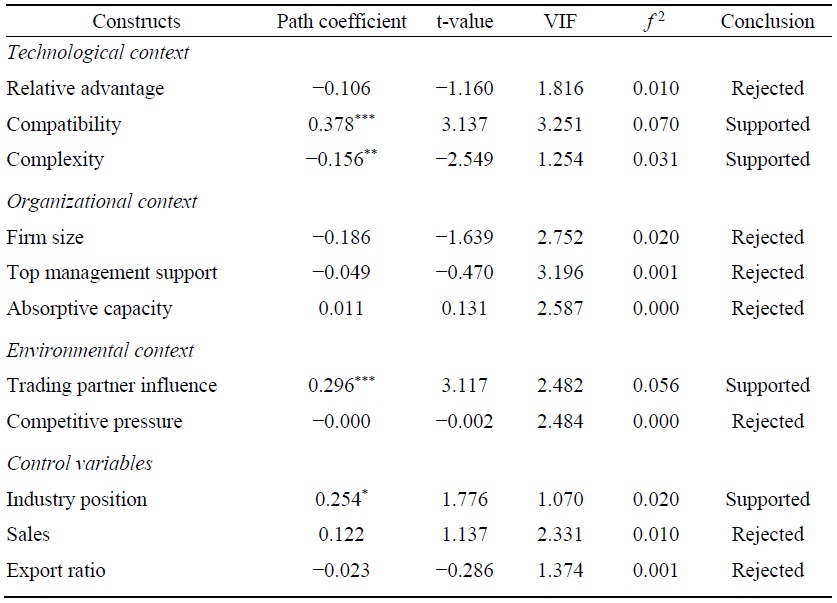
Notes: Adjusted
Table 8.
Endogeneity Test Using the Gaussian Copula Approach
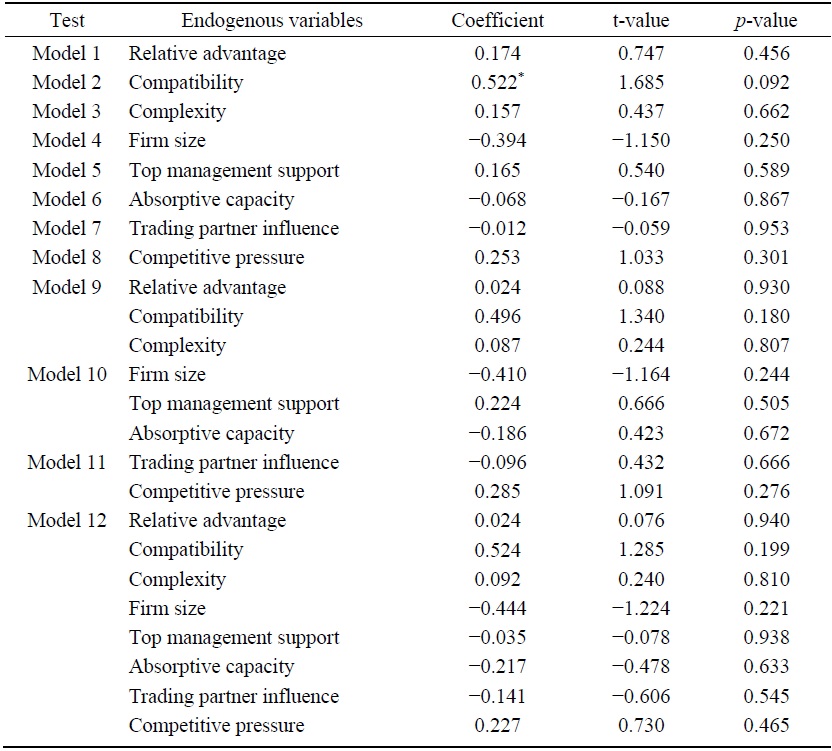
Notes: * significant at the 0.1 level; Bootstrapping based on 5,000 resamples.
References
- Ando, M. and S. Urata. 2018. “Determinants of FTA utilization for Japan’s Imports: Preferential Margins and Restrictiveness of Rules of Origin.” RIETI Discussion Paper Series, no. 18-E-078. Research Institute of Economy, Trade, and Industry.
-
Avkiran, N. K. 2018. “Rise of the Partial Least Squares Structural Equation Modeling: An Application in Banking.” In Avkiran, N. K. and C. M. Ringle. (eds.)
Partial Least Squares Structural Equation Modeling: Recent Advance in Banking and Finance . Cham, Switzerland: Springer. pp. 1-29. -
Baker, J. 2012. “The Technology-Organization-Environment Framework.” In Dwivedi, Y. K., Wade, M. R. and S. L. Schenberger. (eds.)
Information Systems Theory: Explaining and predicting our digital society, vol. 1 . New York, NY: Springer. pp. 231-245. -
Bagozzi, R. and Y. Yi. 1988. “On the Evaluation of Structural Equation Models.”
Journal of the Academy of Marketing Sciences , vol. 16, pp. 74-94.
-
Benguria, F. 2022. “Do US Exporters Take Advantage of Free Trade Agreements? Evidence from the US-Colombia Free Trade Agreement.”
Review of International Economics , vol. 30, no. 4, pp. 1148-1179.
-
Cho, M. J. and B. Y. Choi. 2020. “Analysis of Korea-US FTA Utilization by Firm Size.”
Journal of Market Economy , vol. 49, no. 2, pp. 83-113. (in Korean)
-
Cohen, W. M. and D. A. Levinthal. 1990. “Absorptive Capacity: A New Perspective on Learning and Innovation.”
Administrative Science Quarterly , vol. 35, no. 1, pp. 128-152.
-
Cruz-Jesus, F., Pinheiro, A. and T. Oliveira. 2019. “Understanding CRM Adoption Stages: Empirical Analysis Building on the TOE Framework.”
Computers in Industry , vol. 109, pp. 1-13.
-
Dwivedi, Y. K., Wade, M. R. and S. L. Schneberger. eds. 2012.
Information Systems Theory: Explaining and predicting our digital society, vol. 1 . New York, NY: Springer. -
Estevadeordal, A. 2000. “Negotiating Preferential Market Access: The Case of the North American Free Trade Agreement.”
Journal of World Trade , vol. 34, no. 1, pp. 141-166.
-
Fornell, C. and D. F. Larcker. 1981. “Evaluating Structural Equation Models with Unobservable Variables and Measurement Error.”
Journal of Marketing Research , vol. 18, no. 1, pp. 39-50.
-
Hair, J. F., Hult, G. T. M., Ringle, C. M. and M. Sarstedt. 2022.
A Primer on Partial Least Squares Structural Equation Modeling (PLS-SEM) . Los Angeles, CA: Sage Publications. -
Hair, J. F., Risher, J. J., Sarstedt, M. and C. M. Ringle. 2019. “When to Use and How to Report the Results of PLS-SEM.”
European Business Review , vol. 31, no. 1, pp. 2-24.
-
Hamanaka, S. 2013. “A Note on Detecting Biases in Assessing the Use of FTAs.”
Journal of Asian Economics , vol. 29, pp. 24-32.
-
Hayakawa, K. 2015a. “Does Firm Size Matter in Exporting and Using FTA Schemes?”
Journal of International Trade & Economic Development , vol. 24, no. 7, pp. 883-905.
-
Hayakawa, K. 2015b. “Impacts of FTA Utilization on Firm Performance.”
B.E. Journal of Economic Analysis & Policy , vol. 15, no. 3, pp. 1325-1352.
-
Hayakawa, K., Hiratsuka, D., Shiino, K. and S. Sukegawa. 2013. “Who Uses Free Trade Agreements?”
Asian Economic Journal , vol. 27, no. 3, pp. 245-264.
-
Hayakawa, K., Kim, H. and H.-H. Lee. 2014. “Determinants on Utilization of the Korea–ASEAN Free Trade Agreement: Margin Effect, Scale Effect, and ROO Effect.”
World Trade Review , vol. 13, no. 3, pp. 499-515.
-
Hu, L.-T. and P. M. Bentler. 1999. “Cutoff Criteria for Fit Indexes in Covariance Structure Analysis: Conventional Criteria versus New Alternatives.”
Structural Equation Modeling: A Multidisciplinary Journal , vol. 6, no. 1, pp. 1-55.
-
Hult, G. T. M., Hair, J. F., Proksch, D., Sarstedt, M., Pinkwart, A. and C. M. Ringle. 2018. “Addressing Endogeneity in International Marketing Applications of Partial Least Squares Structural Equation Modeling.”
Journal of International Marketing , vol. 26, no. 3, pp. 1-21.
-
Ifinedo, P. 2011. “Internet/e-business Technologies Acceptance in Canada’s SMEs: An Exploratory Investigation.”
Internet Research , vol. 21, no. 3, pp. 255-281.
-
Kasteng, J., Kokko, A. and P. Tingvall. 2022. “Who Uses the EU’s Free Trade Agreements? A Transaction-level Analysis of the EU-South Korea FTA.”
World Trade Review , vol. 21, no. 1, pp. 93-108.
-
Kawai, M. and G. Wignaraja. 2011. “Main Finding and Policy Implications.” In Kawai, M. and G. Wignaraja. (eds.)
Asia’s Free Trade Agreement: How is Business Responding? Cheltenham: Edward Elgar Publishing Limited. pp. 33-73. - Kim, H. and M. J. Cho. 2010. “Impact of Rules of Origin on FTA Utilization in Korean FTAs.” KIEP Working Paper, no. 10-08. Korea Institute for International Economic Policy.
-
Korea Customs Service. 2022. FTA Portal.
https://www.customs.go.kr/ftaportalkor/main.do (accessed September 21, 2022) -
Korea Federation of Textile Industries (KOFOTI). 2021. “Textile & Apparel Industry Statistics.”
http://www.kofoti.or.kr/textile/boardList.do?Code=STATISTICS_Y (accessed September 21, 2022) -
Lin, H.-F. 2014. “Understanding the Determinants of Electronic Supply Chain Management System Adoption: Using the Technology-Organization-Environment Framework.”
Technological Forecasting and Social Change , vol. 86, pp. 80-92.
-
Mallat, N. and V. K. Tuunainen. 2008. “Exploring Merchant Adoption of Mobile Payment Systems: An Empirical Study.”
E-service Journal , vol. 6, no. 2, pp. 24-57.
-
Moore, G. C. and I. Benbasat. 1991. “Development of an Instrument to Measure the Perceptions of Adopting An Information Technology Innovation.”
Information Systems Research , vol. 2, no. 3, pp. 192-222.
-
Oliveira, T., Thomas, M. and M. Espadanal. 2014. “Assessing the Determinants of Cloud Computing Adoption: An Analysis of the Manufacturing and Services Sectors.”
Information and Management , vol. 51, no. 5, pp. 497-510.
-
Oliveira, T. and M. F. Martins. 2011. “Literature Review of Information Technology Adoption Models at Firm Level.”
Electronic Journal of Information Systems Evaluation , vol. 14, no. 1, pp. 110-121. -
Park, S. and S. Gupta. 2012. “Handling Endogenous Regressors by Joint Estimation Using Copulas.”
Marketing Science , vol. 31, no. 4, pp. 567-586.
-
Picoto, W. N., Bélanger, F. and A. Palma-dos-Reis. 2014. “An Organizational Perspective on m-business: Usage Factors and Value Determination.”
European Journal of Information Systems , vol. 23, no. 5, pp. 571-592.
-
Premkumar, G., Ramamurthy, K. and S. Nilakanta. 1994. “Implementation of Electronic Data Interchange: An Innovation Diffusion Perspective.”
Journal of Management Information Systems , vol. 11, no. 2, pp. 157-186.
-
Premkumar, G. and M. Roberts. 1999. “Adoption of New Information Technologies in Rural Small Businesses.”
Omega , vol. 27, no. 4, pp. 467-484.
-
Ramdani, B., Chevers, D. and D. A. Williams. 2013. “SMEs’ Adoption of Enterprise Applications: A Technology-Organization-Environment Model.”
Journal of Small Business and Enterprise Development , vol. 20, no. 4, pp. 735-753.
-
Ringle, C. M., Wende, S. and J.-M. Becker. 2022. “SmartPLS 4.” Oststeinbek, Germany: SmartPLS GmbH.
http://www.smartpls.com (accessed September 20, 2022) -
Rogers, E. M. 2003.
Diffusion of Innovations . New York, NY: Free Press. -
Sarstedt, M., Ringle, C. M., Cheah, J.-H., Ting, H., Moisescu, O. and L. Radomir. 2020. “Structural Model Robustness Checks in PLS-SEM.”
Tourism Economics , vol. 26, no. 4, pp. 531-554.
-
Song, J.-H. and H.-C. Moon. 2019. “Exploring the Intention of FTA Utilization by Exporting SMEs: Evidence from South Korea.”
Journal of International Logistics and Trade , vol. 17, no. 1, pp. 1-11.
-
Statistics Korea. 2021. “Trade Statistics by Company Characteristics.”
https://kostat.go.kr/portal/korea/kor_nw/1/9/8/index.board (Accessed September 22, 2022. in Korean) -
Statistics Korea. 2022. “Distribution by Ratio of Exports to Sales.”
https://kosis.kr/statHtml/statHtml.do?orgId=142&tblId=DT_34006E_010 (accessed September 21, 2022. in Korean) -
Takahashi, K. and S. Urata. 2010. “On the Use of FTAs by Japanese Firms: Further Evidence.”
Business and Politics , vol. 12, no. 1, pp. 1-15.
-
Teo, T. S. H., Lin, S. and K.-H. Lai. 2009. “Adopters and Non-adopters of e-procurement in Singapore: An Empirical Study.”
Omega , vol. 37, no. 5, pp. 972-987.
-
Tornatzky, L. G. and M. Fleischer. 1990.
The Processes of Technological Innovation . Lexington, MA: Lexington Books. -
Wang, Y.-S., Li, H.-T., Li, C.-R. and D.-Z. Zhang. 2016. “Factors Affecting Hotels’ Adoption of Mobile Reservation Systems: A Technology-Organization-Environment Framework.”
Tourism Management , vol. 53, pp. 163-172.
-
Wignaraja, G. 2014. “The Determinants of FTA Use in Southeast Asia: A Firm-level Analysis.”
Journal of Asian Economics , vol. 35, pp. 32-45.
-
World Trade Organization. 2022. “Regional trade agreements.”
https://www.wto.org/english/tratop_e/region_e/region_e.htm (accessed March 17, 2022)



